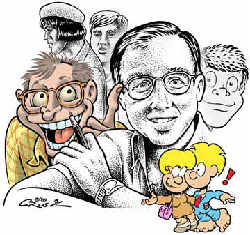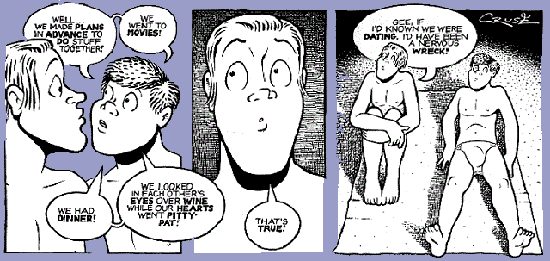Joe Corallo: Howard Cruse, American Advocate
Last Thursday, the LGBT Community Center here in Manhattan (a.k.a. The Center) had its opening reception for their exhibit Wendel’s World: Gay Life in the 1980s. For those of you that don’t know, Wendel was a comic that ran in The Advocate throughout the 1980s created and drawn exclusively by the underground comix pioneer, Howard Cruse.
The reception was filled people who have been passionate fans of Howard’s for decades, as well as some newcomers. The walls of the fourth floor of The Center were decked out in framed Wendel pages including one of my favorites where Wendel’s good friend Sterno has fun at his place with Cyril. Other notable LGBT cartoonists such as Ivan Velez and Jennifer Camper were in attendance, as well as Howard’s husband Eddie Sedarbaum. They also had wine and cheese which isn’t a reason to go to these sort out things, but it sure is nice.
 If you haven’t read Wendel yet, do it. The entire run of the strips from The Advocate published between 1983 through 1989 is available in the still in print The Complete Wendel. Howard Cruse managed to craft a story about a young gay man, Wendel, with a large supporting cast including Ollie, his boyfriend, and his over-the-top friend Sterno – and that’s putting it nicely. The large cast of background and recurring characters brings Wendel to life in a way that many other comics are unable to accomplish and help to suck you into this world.
If you haven’t read Wendel yet, do it. The entire run of the strips from The Advocate published between 1983 through 1989 is available in the still in print The Complete Wendel. Howard Cruse managed to craft a story about a young gay man, Wendel, with a large supporting cast including Ollie, his boyfriend, and his over-the-top friend Sterno – and that’s putting it nicely. The large cast of background and recurring characters brings Wendel to life in a way that many other comics are unable to accomplish and help to suck you into this world.
The other element that brings this strip to life is the variety in the subject matter. Whereas many other attempts to talk about gay life over the years are often too tempted to dwell solely on the sex and scandal aspect, Howard crafts a story about community. More than a few Wendel strips tackle the tedium and egos that populate bureaucracy in any progressive movement and helps to show that the gay community in the 1980s was not a monolith, but a complex web of clashing priorities and ideologies in a way that few people have been able to replicate since then. Certainly in comics.
All of those are reasons that Wendel, and particularly Howard Cruse, should be acknowledged at The Center. Howard’s influence in comics, particularly LGBT comics, extends far beyond the 1980s though. The decade prior saw his comic Barefootz as well as his contributions to Gay Comix after being tapped to edit it by Denis Kitchen at Kitchen Sink Press. The 1990s would see his Eisner award winning graphic novel, Stuck Rubber Bab. Since then, he’s had much of his previous work bought back in print, has had new work in anthologies like Jennifer Camper’s Juicy Mother, Northwest Press’ Qu33r, as well as his own occasional comix that he posts online here.
Throughout all of his work in comics, Howard Cruse has advocated to give the gay community a voice through his work, and later on through Stuck Rubber Baby incorporating the Civil Rights Movement into gay rights in a way that has rarely been done before or since. Howard has managed to create such powerful works in part because he himself is an activist and has been on the front lines of the gay rights movement for decades and his cartooning in many ways has been more a tool for his activism than just a profession.
It’s great to see Howard’s comics like Wendel being recognized today. Maybe soon we’ll see Stuck Rubber Baby get more recognition for being the groundbreaking work that it was as well. If you haven’t gotten around to these works, it’s not too late to pick them up. And if you have, Howard’s still cranking out comics so make sure you check out his site from time to time to see if a new one has popped up. And hey, if you really like his comics you can drop him a note on his site. He’ll appreciate it.















